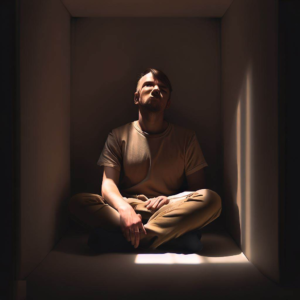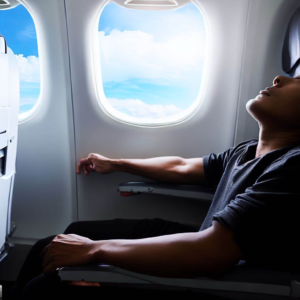Imagine being in a crowded elevator, with people pressing against you from all sides. The walls of the elevator seem to be closing in on you and your heart starts pounding. You feel like you can’t breathe and need to get out immediately.
This is what it feels like for someone with claustrophobia, an intense fear of small spaces. Claustrophobia can be a debilitating condition that affects many individuals, causing them to avoid certain situations or places altogether.
However, there are strategies that can help manage this fear and allow individuals to live their lives without feeling trapped or overwhelmed. In this article, we will explore some coping mechanisms such as hypnosis, breathing techniques, cognitive-behavioral therapy, exposure therapy and seeking professional help that have proven to be effective in managing claustrophobia.
Understanding Claustrophobia and Its Symptoms
 You may not realize it, but claustrophobia can cause intense physical and emotional symptoms that can make even the smallest of spaces feel unbearable.
You may not realize it, but claustrophobia can cause intense physical and emotional symptoms that can make even the smallest of spaces feel unbearable.
Claustrophobia is an anxiety disorder characterized by a fear of enclosed or tight spaces. The causes and triggers of this condition vary from person to person, but some common factors include past traumatic events, genetics, and personality traits.
When you experience claustrophobia, your body reacts in several ways. You may feel shortness of breath, rapid heartbeat, sweating, trembling, or shaking. These physical sensations can lead to feelings of panic or terror and may cause you to avoid situations that trigger your fear.
As a result, you might begin to limit yourself in various areas of life such as traveling on public transportation or attending social events in confined spaces.
It’s important to understand that there are strategies for managing claustrophobia symptoms so that you can live without undue limitations. For instance, learning relaxation techniques like deep breathing exercises or visualization can help calm your mind when feeling anxious.
Additionally, exposure therapy is a technique used by therapists where they gradually expose patients to increasingly confined spaces while teaching them how to manage their fears through coping mechanisms such as mindfulness and positive self-talk.
Breathing and Relaxation Techniques
Take a deep breath and relax your muscles, as studies show that practicing relaxation techniques can decrease heart rate and alleviate tension in the body.
Meditation exercises are one of the most effective ways to calm your mind and body. You can try sitting in a quiet place, closing your eyes, and focusing on your breath for a few minutes every day. Visualize yourself in a peaceful environment while inhaling deeply through your nose, holding it for a few seconds, then exhaling slowly through your mouth.
Another way to reduce anxiety is through visualization techniques. Imagine yourself surrounded by an open space or visualize opening up the walls around you. Alternatively, picture yourself in a comfortable place that makes you feel safe and secure. Incorporating these images into your daily routine can help train your mind to associate small spaces with feelings of security rather than fear.
In addition to meditation and visualization exercises, there are other breathing techniques that you can use when feeling anxious in small spaces.
One technique is called 4-7-8 breathing: inhale deeply through your nose for four seconds, hold the breath for seven seconds, then exhale slowly through pursed lips for eight seconds. Repeat this process several times until you start feeling more relaxed.
Remember that coping with claustrophobia takes practice and patience. By incorporating these relaxation strategies into your daily routine, you’ll gradually learn how to manage anxiety symptoms when confronted with small spaces.
With time and effort, it’s possible to overcome claustrophobia and live life free from fear!
Cognitive-Behavioral Therapy
If you’re struggling with feeling trapped or overwhelmed in enclosed environments, cognitive-behavioral therapy may be a helpful approach to address the root of your anxiety and learn coping mechanisms to alleviate it.
CBT techniques focus on identifying negative thought patterns and replacing them with more positive, realistic ones. By using this method, you can change the way you perceive small spaces and reduce your fear.
CBT can help you overcome anxiety by teaching you how to recognize triggers that cause feelings of claustrophobia and develop strategies for managing them. You’ll work with a therapist who will guide you through exposure therapy, gradually exposing yourself to small spaces until they no longer produce intense fear.
Additionally, relaxation techniques such as deep breathing exercises can be incorporated into CBT sessions to help ease anxious thoughts and promote calmness.
It’s important to remember that everyone’s journey with claustrophobia is unique, so there is no one-size-fits-all approach to treatment. However, by seeking out cognitive-behavioral therapy from a licensed professional, you can gain valuable tools for managing your fear and reclaiming control over your life.
With time and practice, these techniques can become second nature and help you feel more comfortable in any situation – no matter how tight the space may be.
Exposure Therapy
Imagine stepping out of your comfort zone and gradually exposing yourself to more and more challenging situations like a butterfly emerging from its cocoon through exposure therapy, allowing you to spread your wings and conquer your fears.
Exposure therapy is a type of cognitive-behavioral therapy that helps individuals overcome their phobias by exposing them to the feared object or situation in a controlled environment. Virtual reality has become an increasingly popular tool for exposure therapy, as it allows patients to experience simulations of real-life scenarios that trigger their claustrophobia.
During exposure therapy sessions, patients are gradually exposed to stimuli related to their fear in a safe and controlled environment. This desensitization process can be done through various exercises such as imagining oneself in small spaces, practicing deep breathing techniques, or using virtual reality simulations.
The goal is for patients to learn how to manage their anxiety response until they no longer feel threatened by the situation. Exposure therapy has been shown to be an effective treatment for claustrophobia, helping individuals regain control over their lives by reducing avoidance behaviors and improving quality of life.
However, it’s important to note that exposure therapy should only be conducted under the guidance of a licensed mental health professional who specializes in this form of treatment. With time and practice, exposure therapy can help you overcome your fear of small spaces, so you can live life without limitations.
Seeking Professional Help
Seeking professional help can be a crucial step towards overcoming the limitations that come with living with a phobia, like claustrophobia.
Medication options and finding a therapist who specializes in treating anxiety disorders can provide you with the support you need to manage your symptoms and work through your fears.
When it comes to medication, there are various options available to alleviate symptoms of claustrophobia. Anti-anxiety medications such as benzodiazepines or selective serotonin reuptake inhibitors (SSRIs) may be prescribed by your doctor. However, it’s important to note that medication should always be used in conjunction with therapy, rather than as a standalone treatment.
Finding a qualified therapist who has experience treating individuals with claustrophobia can help you develop coping strategies and techniques for managing your fear in small spaces.
A therapist may use exposure therapy or cognitive-behavioral therapy (CBT), which involves gradually exposing you to feared situations while helping you learn how to manage anxiety and stress responses. With their guidance and support, you can develop tools for managing your claustrophobia and improve your quality of life.
Are there any medications that can help with claustrophobia?
You’re in luck! There are plenty of medication alternatives that can potentially help with claustrophobia.
However, let’s start with the irony – unfortunately, some of these medications can actually cause side effects that may worsen your fear of small spaces. It’s important to weigh the potential benefits against the risks and consult with a healthcare professional before taking any medication.
Some options include anti-anxiety drugs like benzodiazepines or antidepressants like selective serotonin reuptake inhibitors (SSRIs). Other non-medication alternatives, such as therapy or relaxation techniques, may also be effective in managing claustrophobia.
Can claustrophobia be cured completely?
Therapy options and self-help techniques can assist in managing claustrophobia, but a complete cure may not be possible.
Exposure therapy, cognitive-behavioral therapy, and virtual reality therapy are some of the therapeutic methods that have been used to treat claustrophobia. These therapies help individuals gradually confront their fears in a controlled environment, learn coping mechanisms for anxiety, and change negative thought patterns related to small spaces.
In addition to therapy, self-help techniques such as deep breathing exercises or visualization can also alleviate symptoms of claustrophobia. However, it’s important to note that while these strategies can improve one’s ability to manage their fear, they may not completely eliminate the phobia.
Is there a genetic component to claustrophobia?
Wondering if claustrophobia runs in your family? You may be interested in exploring the genetic component of this fear.
Genetic testing can reveal whether certain genes are associated with a higher likelihood of developing claustrophobia, and family history can also offer clues as to whether there is a hereditary component.
However, it’s important to remember that genetics are just one piece of the puzzle when it comes to phobias. Environmental factors, life experiences, and individual temperament can all play a role in the development of claustrophobia.
Regardless of its origin, seeking support and treatment for your fears can help you manage them more effectively and live a fuller life.
Can children develop claustrophobia?
Childhood onset of claustrophobia is possible, although it isn’t as common as in adults. Usually, children who develop this phobia have experienced a traumatic event or have a family history of anxiety disorders.
Parental support and understanding are crucial in managing their fear. It’s important to avoid forcing them into situations that trigger their claustrophobia and instead gradually expose them to small spaces with the help of a therapist.
Encouraging relaxation techniques such as deep breathing exercises can also be helpful. Remember to validate your child’s feelings and provide reassurance throughout the process.
Are there any alternative therapies that can help with claustrophobia?
Hypnotherapy is an alternative therapy gaining popularity for its benefits in managing claustrophobia. During a hypnotherapy session, the therapist guides you into a relaxed state and helps you access your subconscious mind to identify triggers that cause your fear of enclosed spaces. This technique can help reprogram those negative thought patterns and replace them with positive ones.
Additionally, there are natural remedies such as essential oils and herbal supplements that can aid in reducing anxiety and promoting relaxation. While these alternative therapies may not work for everyone, they offer a non-invasive approach to managing claustrophobia symptoms.
It’s important to consult with a healthcare professional before trying any alternative therapies as they may interact with medications or have adverse effects on some individuals.
Coping with claustrophobia can be a challenging journey, but there are numerous strategies that you can use to manage your fear in small spaces.
By understanding the symptoms of this condition, you can take steps to alleviate your anxiety and improve your quality of life.
Whether you choose to use breathing and relaxation techniques, cognitive-behavioral therapy, exposure therapy, or seek professional help, it’s important to remember that you’re not alone.
Visualize yourself conquering your fears as if you were climbing a mountain or swimming through rough waters. With each step forward and every breath taken, you’ll become stronger and more resilient in the face of claustrophobia.
Remember to be patient with yourself and celebrate every victory along the way.





